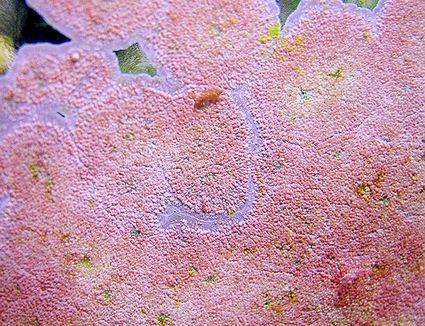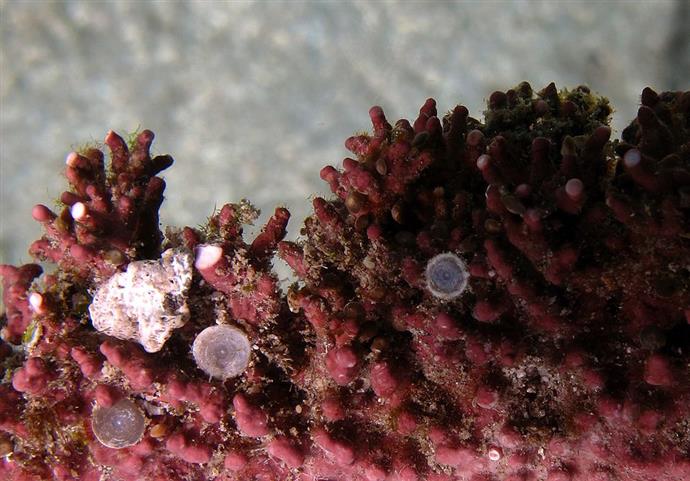- 01 of 04
Encrusting Coralline Algae

Encrusting coralline algae growth gives many saltwater aquariums a pinkish-red color, and most marine aquarists aim for a good covering of the algae. Although coralline algae comes in a number of different colors—there are more than 1,600 species—it’s usually thought of as pink, red, purple, or some shade in the same color family.
Unlike brown, green hair, and red slime algae, all of which frequently grow in your tank whether you like it or not, coralline algae must be physically brought into your tank for it to reproduce and populate the various surfaces.
Coralline algae can be introduced to your tank by installing:
- Coralline-covered live rock
- Coralline scrapings from another tank
- Commercial coralline algae starter packages
The more species of coralline that you add to your tank, the more you will see growing on your live rock, substrate and aquarium walls.
Once you have some coralline algae growth in your tank, let it grow and spread by turning off all tank filters and skimmers, leaving any powerheads running. With a single-edged razor blade, scrape the existing coralline off the front and side tank walls. The water current generated by the powerhead will spread the coralline scrapings throughout the tank where they will continue to grow. After an hour or so, turn the skimmers and filters back on.
Continue to 2 of 4 below.
- 02 of 04
Coralline Algae Lighting

As with other forms of algae, coralline algae requires light. Exactly how much or little light is required for optimum Coralline growth is debatable, but it appears that some types of coralline algae prefer higher lighting, while others prefer low lighting. Aquarists have found that as their tank lights get older and the spectrum and intensity fades, some of their coralline growths actually increase. However, these growths die off in the well-lit areas and increase in the lower and/or shaded areas of the tank when the lights were replaced.
What type of lighting is best? There is no single answer. Some types of coralline will grow better under certain lighting while other types will grow better under a different lighting. For the most part, it seems that coralline will grow under minimal reef type lighting.
Continue to 3 of 4 below.
- 03 of 04
Coralline Algae Water Chemistry

While lighting is important, maintaining excellent water quality might be the biggest factor in growing a good crop of coralline. Like hard corals, coralline algae growth is calcareous by nature, requiring many of the same things coral does in order to flourish:
- SG apx 1.024
- Calcium: 350 to 480 ppm
- Carbonate alkalinity: Between 2.5 and 4.0 meq/L (7-12 dKH)
- Strontium
- Low phosphates (Close to 0)
- Low nitrates (5 ppm or lower)
Many aquarists have found that performing regular water changes will keep the phosphate and nitrate levels in check, as well as keeping the calcium, alkalinity, and strontium at or near optimum levels. Using mangroves can also be a simple and inexpensive method for reducing nitrates and phosphates, and using calcium and strontium additives produces the same or better results without the constant expense of sea salts and RO/DI water required for water changes. Additionally, many aquarists have also found that using a good protein skimmer goes a long ways towards controlling nitrates and phosphates.
Continue to 4 of 4 below.
- 04 of 04
Causes of Disappearing Coralline Algae

Once they have established a healthy Coralline population in their tanks, many aquarists are puzzled by what appears to be a constant reduction in their Coralline colonies. If the water quality is being kept at the optimum level, what could be the cause? Some possibilities are:
- Urchins
- Crabs
- Snails
Spending some time watching your tank critters at work will reveal which of them is attacking your coralline algae growth.
How to Grow Coralline Algae in a Saltwater Aquarium
- Advertisement -

